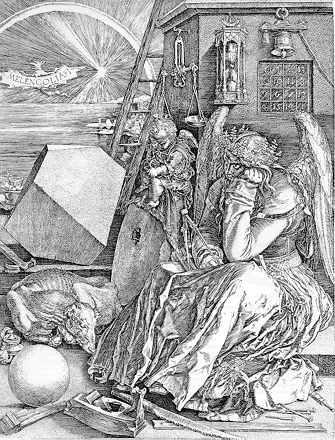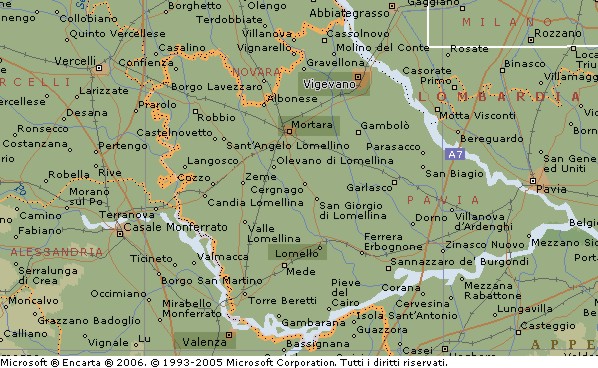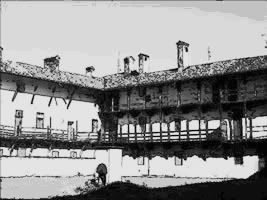I comuni della Lomellina sono 61 con circa 170.000 abitanti.
E’ una terra ricca di storia, in cui si sono insediati Celti, Romani e Longobardi che hanno lasciato tracce indelebili.
Gli itinerari lomellini incuriosiscono gli amanti dei castelli, che da Sartirana a Cozzo e da Scaldasole a Valeggio ricordano visivamente l’organizzazione feudale del Medioevo. Un itinerario dedicato all’architettura sacra permette di scoprire validissimi monumenti, come il complesso della chiesa e del battistero di Lomello, dell’Abbazia di San Pietro a Breme, della vetusta Abbazia di Sant’Albino e del Duomo di San Lorenzo a Mortara.
..terra d’Acqua
Va, ad esempio, ricordato che l'abile sfruttamento delle acque sorgive attuato nella Pianura Padana non passò inosservato alla vivace curiosità e alla grande fantasia di Leonardo da Vinci. Durante la sua permanenza a Milano Leonardo progettò infatti un palazzo per Carlo d’Amboise, prevedendo la costituzione di un "giardino di delizie" con una voliera, dotata di una copertura di rete di rame e un mulino a vento per aspirare "acqua surgitiva e fresca" e produrre "continui suoni di vari strumenti". (link vigevano)
“ Nelle giaciture regolari, a profondità quasi costante di due a quattro metri, si trovano quelle acque sotterranee, che quando secondano per tal modo il declivio della pianura, portano il nome antico e locale di àveso (fontanile)”
Carlo Cattaneo, Notizie naturali e civili su la Lombardia , 1844
L’ultimo censimento dei fontanili realizzato dall'Est Sesia ha permesso di localizzarne circa 166 e in tema di fontanili non è difficile imbattersi nei vari racconti che le popolazioni contadine hanno ambientato presso i luoghi sorgivi trasformandoli in centri di culto e di "magia",infatti molte abbazie, cappelle, chiese e santuari sono nati in prossimità di acque sorgive, come le interessantissime Abbazie di S.Albino a Mortara e di Acqualunga a Frascarolo.
Ma la gente contadina ha creato sulle acque sorgive una miriade di altre credenze e superstizioni degne di nota.
Ad esempio, per beneficiare di virtù guaritrici un’antica credenza consigliava di immergersi nell’acqua sorgiva nella notte di San Giovanni, quando si credeva che streghe e diavoli vagassero nelle tenebre.
Le reminescenze di questi culti e credenze si sono integrate nella storia della civiltà agricola della Pianura Padana irrigua in modo vario e curioso. Ad esempio, nei repertori dei riti magici degli antichi guaritori della Lomellina viene citata più volte la "Madonna della Fontana" con l’aggiunta di preghiere che mettono in evidenza l’azione purificatrice dell’acqua: "acqua curìa, ciàpa él mè mal e pòrtal vìa" (acqua corrente, prendi il mio male e portalo via). La frase veniva pronunciata presso il fontanile, facendo il gesto di mandare il proprio malanno nell’acqua.
A questo proposito è utile ricordare come la ricerca delle acque per costruire il fontanile abbia mantenuto nei secoli, fino a pochi decenni fa, elevati riferimenti a riti magici e collegamenti a forze soprannaturali collegati alla figura del "Rabdomante".
(vedi Albonese: il mostro del fontanile)
Libri e autori consigliati:
ROLANDO DI BARI Storia della provincia di Pavia -Appendice a cura di Marziano Brignoli
(Ed. Punto e Virgola - marzo 2006 – Vigevano)
RINALDO BERNARDIhttp://www.rinaldobernardi.com/pagine/index.php
MARIA ANTONIETTA ARRIGONI E MARCO SAVINI
TRE GOCCE DI VELENO - Fiabe magiche raccolte in Lomellina (Edizioni dell’Orso)

http://translate.google.com/
Lomellina
..
Lomellina
is a fertile plain of 1263 square kilometers and geographically bounded by the
rivers Ticino and Sesia, Po , which takes its name from the village of Lomello
.Municipalities are Lomellina 61 with about 170,000 inhabitants.It ' a land
rich in history, in which they have settled Celts, Romans and Lombards who left
an indelible mark .The routes Lomello intrigue lovers of castles , which
Sartirana in Cozzo and Scaldasole Valeggio visually reminiscent of the feudal
organization of the Middle Ages . An itinerary dedicated sacred architecture
allows you to discover very valuable monuments, such as the complex of the
church and the baptistery of Lomello , the Abbey of St. Peter in Bream , of the
venerable Abbey Sant'Albino and the Cathedral of San Lorenzo Mortara .
Ground
Water ..
The
Lomellina is ' a land of springs , but was once a swamp inhospitable. In the
Middle Ages the monks with the reclaimed water meadows , which were then
followed by colonization in the thirteenth century feudal and agricultural
reforms inaugurated by the Sforza , who introduced the cultivation of rice.
Through the centuries , between the rivers was created a complex water system
of ditches and canals that transformed the territory , making it suitable for
the cultivation of corn, wheat, rice and fodder. Between rivers and fields,
mills have sprung the unmistakable and typical Lombard farmhouse in closed
court, in addition to charming villages of bellezza.Recentemente much has been
done to recover the ancient habitat of the area, such as the establishment of
the Ticino River delParco , including the area around the ancient Yangtze River
called by the Celts " Tes -inn " , a place of magic cults and
paganiNella Lomellina aquifers , groundwater, originally fed only by rain and
flood waters of natural streams , it is over time are more and more enriched
with the contributions due to irrigation , the extent of which was gradually
growing due to higher amount of water made available by the
construction of the great historic canals , to this end , it was the
fundamental contribution of Cavour Canal , derived from the Po and supplemented
by Baltea, and channel Regina Elena, fed by the waters of the Ticino.
It should ,
for example, pointed out that the skillful exploitation of the spring waters
implemented in the Po Valley did not go unnoticed to the lively curiosity and
imagination of the great Leonardo da Vinci. During his stay in Milan, Leonardo
designed in fact a palace for Charles d'Amboise , providing for the
establishment of a " garden of delights" with an aviary , with a
network coverage of copper and a windmill to suck up " water and surgitiva
fresh " and produce" continuous sounds of various instruments .
" (link existed )
The Magic
Fountains
"In
giaciture regular , almost constant at depths of two to four meters, there are
those groundwater , so that when secondano for the slope of the plain, named
after the ancient and local àveso ( fountain ) "Carlo Cattaneo , natural
and civil News of Lombardy, 1844
The last
census of springs made from Eastern Sesia has
allowed us to localize approximately 166 and in terms of
springs is not hard to
come across in the various stories that the peasant population were set at the
spring-fed turning
centers places of worship and "magic" in fact, many abbeys , chapels,
churches and shrines were born in the vicinity of the spring waters , such as
the very interesting abbeys of S.Albino Mortara and Acqualunga in Frascarolo . But
people on spring waters farmer has created a host of other beliefs and
superstitions worthy of note. For example, to receive healing virtues ancient
belief advised to dive into the water spring on the night of St. John, when it
was believed that witches and devils wander in darkness .The reminiscences of
these cults and beliefs are embedded in the history of the Po Valley irrigated
agricultural civilization in a varied and curious. For example, in the
repertoires of the magical rites of the ancient healers of Lomellina is
mentioned several times the " Lady of the Fountain " with the
addition of prayers that highlight the purifying action of the water , "
water Curia , Ciapa él mè ill and Portal way " ( running water , take my
hurt and take it away ) . The sentence was uttered at the fountain , making the
gesture of sending your ailment in the water.In this regard it is useful to
remember that the search of the waters to build the fountain has maintained
over the centuries, until a few decades ago, high references to magic rites and
links to supernatural forces linked to the figure of " Dowsing " . (see
Albonese : the monster of the fountain )
La
Lomellina ..
La
Lomellina est une plaine fertile de 1263 kilomètres carrés et géographiquement
délimitée par les rivières tessinoises et Sesia , Pô, qui tire son nom du
village de Lomello .Les municipalités sont Lomellina 61 avec environ 170 000
habitants .C'est une terre riche en histoire , dans laquelle ils se sont
installés les Celtes, les Romains et les Lombards qui a laissé une marque
indélébile .Les routes Lomello amoureux de l'intrigue de châteaux, qui
Sartirana dans Cozzo et Scaldasole Valeggio visuellement rappelle
l'organisation féodale du Moyen Age . Une architecture sacrée dédiée
itinéraire vous permet de découvrir les monuments de grande valeur , tels que
le complexe de l'église et le baptistère de Lomello , l'abbaye de Saint-Pierre
de brème , de la vénérable abbaye Sant'Albino et la cathédrale de San Lorenzo
Mortara .
Ground
Water .. La Lomellina est « une terre de ressorts , mais était autrefois un
marécage inhospitalier . Au Moyen Age, les moines avec les prairies de l'eau
récupérée , qui ont ensuite été suivis par la colonisation dans les réformes
féodaux et agricoles treizième siècle inauguré par les Sforza , qui ont
introduit la culture du riz . A travers les siècles , entre les rivières a été
créé un système complexe de l'eau des fossés et des canaux qui ont transformé
le territoire , ce qui convient pour la culture du maïs , du blé , du riz et du
fourrage . Entre rivières et les champs , les usines ont vu la ferme unique et
typique Lombard dans cour fermée , en plus de charmants villages de
bellezza.Recentemente beaucoup a été fait pour récupérer l'ancien habitat de la
région, telles que la création de la rivière Tessin delParco , y compris la
zone de l'ancien fleuve Yangtze appelé par la Celtes " Tes- auberge "
, un lieu de cultes magiques et des aquifères paganiNella Lomellina , les eaux
souterraines , à l'origine alimenté que par les eaux de pluie et de crue des
cours d'eau naturels , il est au fil du temps sont de plus en plus enrichi avec
les contributions dues à l'irrigation , la mesure de ce qui a été
progressivement de plus en plus en raison de plus grande quantité d' eau mis à
disposition par la construction de grands canaux historiques , à cette fin , il
a été la contribution fondamentale de Canal Cavour , dérivé du Po et complétée
par Baltée , et le canal Regina Elena , alimenté par les eaux du Tessin . Il
devrait , par exemple , a souligné que l'exploitation habile des eaux de source
mis en œuvre dans la vallée du Pô n'est pas passée inaperçue à la vive
curiosité et l'imagination du grand Léonard de Vinci . Pendant son séjour à
Milan , Leonardo conçu en fait un palais de Charles d'Amboise , prévoyant la
création d'un " jardin des délices " avec une volière , avec une
couverture de réseau de cuivre et d'un moulin à aspirer » l'eau et surgitiva
sons continus frais " et " produire de divers instruments . " (
Lien existait )
Le Fontaines Magiques
" En giaciture régulière , presque constante à une
profondeur de deux à quatre mètres , il ya ceux des eaux souterraines , de
sorte que lorsque secondano pour la pente de la plaine , nommé d'après l'ancien
et local àveso ( fontaine ) "Carlo Cattaneo , Nouvelles naturelle et
civile de Lombardie 1844
Le dernier
recensement de ressorts faits de Sesia l'Est nous a permis de localiser environ
166 et en termes de ressorts n'est pas difficile de rencontrer dans les
diverses histoires que la population paysanne ont été fixés au Centres de
tournage alimentés par des sources de lieux de culte et " magiques "
en fait , de nombreuses abbayes, chapelles , églises et sanctuaires sont nés à
proximité des eaux de source , comme les abbayes très intéressants de S.Albino
Mortara et Acqualunga dans Frascarolo . Mais les gens sur les eaux de source
agriculteur a créé une foule d'autres croyances et superstitions dignes de
mention . Par exemple , pour recevoir des vertus curatives ancienne croyance
conseillé de plonger dans la source d'eau de la nuit de la Saint -Jean, où l'on
croyait que les sorcières et les démons errent dans l'obscurité . Les
réminiscences de ces cultes et croyances sont intégrés dans l'histoire de la
civilisation agricole irriguée dans la vallée du Pô un varié et curieux . Par
exemple , dans les répertoires des rites magiques des anciens guérisseurs de
Lomellina est mentionné à plusieurs reprises la «Dame de la Fontaine "
avec l'ajout de prières qui mettent en valeur l'action de purification de l'eau
, " Curie de l'eau , Ciapa él mè malades et Portal Way " ( eau
courante , prendre mon mal et l'emporter ) . La sentence a été prononcée
à la fontaine , faisant le geste de l'envoi de votre affection dans l'eau . À
cet égard , il est utile de rappeler que la recherche des eaux de construire la
fontaine a maintenu au cours des siècles , jusqu'à il ya quelques décennies ,
les références élevés à des rites et des liens vers des forces surnaturelles
liées à la figure du " Radiesthésie " magiques . ( Voir Albonese : le
monstre de la fontaine )


| 39 | XLII | Tremel | Tromello | Vercelli - Robbio | 19.7 |
| Robbio - Mortara | 14.2 | ||||
| Mortara - Tromello | 18.1 | ||||
| 40 | XLI | Pamphica | Pavia | Tromello - Gropello Cairoli | 13.5 |
| Gropello Cairoli - Pavia | 18.1 |







